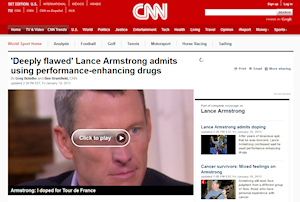 The power of stories, whether personal, internal sagas or those we read and hear in the media, have a greater ability to capture and hold our attention than any other form of content imaginable. No use in fighting it, its part of our DNA.
The power of stories, whether personal, internal sagas or those we read and hear in the media, have a greater ability to capture and hold our attention than any other form of content imaginable. No use in fighting it, its part of our DNA.
Take for example the mythical story of Lance Armstrong. A man who battled and won a fight against cancer, who then returned to professional cycling and claimed a record number of Tour de France victories. A father. A fighter. A winner. Could there possibly be any better story than this?
Most of the world, including myself, believed so strongly in this unimaginable true life triumph that it was hard to tolerate any dialogue to the contrary. Rumors of Lance’s illegal doping have floated in the tabloids for years and have surrounded his sport for so long that I can’t honestly remember a time when Lance wasn’t accused of cheating at some level.
But the power of his story was so strong and struck me so deeply that I refused to believe his guilt until I heard it leap from his own lips. I’m deeply saddened by his public apology (if you can call it that) but find this an opportune time to reflect on the true power of story telling.
If you really stop to think about it, Lance Armstrong isn’t just an athlete, he is a brand unto himself. We all bought into the ideals of his foundation (c’mon, admit it… you wore a yellow bracelet), his athleticism, and his personality. And this is no different from how consumers buy into the “personality” of the brands they choose to support.
You see, strong brands have both an internal and external story that combine to complete their market image. The external story mainly consists of the product’s attributes and the benefits that the product provides. This is the “how we do business” part of their story.
On the other hand, a brand’s internal story is the core belief system and motivation a company has for being. This is essentially the “why we do what we do” and it’s the foundation for building strong customer loyalty. If you think of the big name, successful brands in the world you can begin to extract their internal story and quickly understand why we love them so deeply.
Product attributes and benefits can often be challenged by competitors. But it’s the brand’s core beliefs and values, when properly aligned with customer ideals, that protect lasting companies from market threats. And it’s through the brand’s story, not the marketing and advertising, that we form our personal connections to the companies we trust.
And so it goes that when Lance admitted his guilt, the entire cookie crumbled. When the story we believed so deeply turned out to be a lie, it was devastating. As a believer, it’s extremely hard to swallow the realization that the brand I’ve supported for years is a complete sham. I take it personally; to the point of going on the offensive against Lance and everything he’s conditioned me to believe over the last decade. If I bumped into him on the streets I’d have nothing but 4 words to say. “Thanks for nothing, asshole.”
So as you’re building your own brand, be it personal or corporate, remember to stay true to your beliefs. It’s when a company says one thing and turns out to be something entirely different that we tend to feel let down.
Define your brand, craft your story, hold true to your core beliefs, and walk that path daily. If you do this, yours will be the story we remember and cherish for years to come.
*** P.S. if you want to hear a sports-related story that really DOES stem from a place of caring, check this out. If someone asked me today if I would rather donate a dollar to these kids or Lance Armstrong, my answer would be Team Long Brothers… 12 times out of 10.